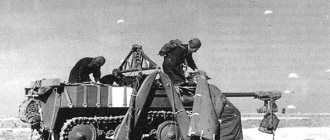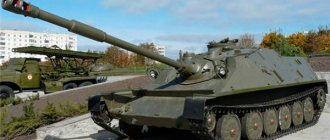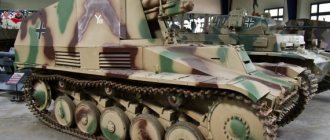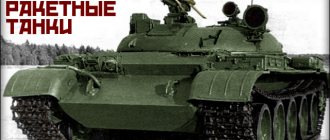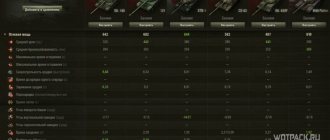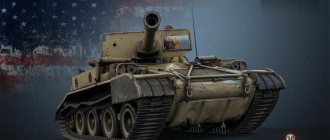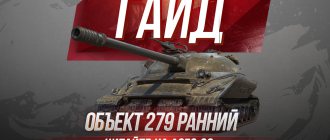Characteristics of the self-propelled gun 2A3 “Kondensator-2P”
A country:USSRType:Self-propelled gunDate of issue:1955Length:20 m (with gun)Width:3.08 mHeight:5.75 mArmor, forehead:NoArmor, side:NoArmor, tower:NoCrew:7 peopleEngine:Diesel V-12-6B, supercharged, 751 hp.Travel range:200 kmMaximum speed:No informationWeight:64 tonsWeapons:1x 406.4 mm SM-54 cannon with a firing range of 25.6 km
The history of the creation of the 2A3 “Kondensator-2P” self-propelled gun
By the mid-1950s, not a single country in the world had missiles capable of covering the distance separating continents and hitting strategic targets on enemy territory with a nuclear charge. Yes, although the United States and the USSR already had enough nuclear weapons in their arsenals to stop any war at one moment, they could not fully use them. Various exotic projects of “atomic guns” were given the green light, but although the Americans were significantly successful in their construction, the USSR wiped their nose out of them in 1955, and for one thing surprised the whole world.
“Our answer” was nothing other than a real combat monster, named “Kondensator-2P” (“object 271”) with the index 2A3 . Just by its appearance, this colossus weighing 60 tons, 20 meters long and 6 meters high could amaze the imagination. But it was also self-propelled, and capable of firing over a distance of over 25 kilometers. Of course, using nuclear shells for this. But what was most striking was the monstrous caliber of the supergun - 406 mm!
Self-propelled gun 2A3 “Kondensator-2P” (object 271)
The “Condenser-2P” project was not the only one; along with it, work was also carried out on the creation of a self-propelled 420-mm mortar 2B1 “Oka” (“object 273”), both projects were approved by a decree of the USSR Council of Ministers of April 18, 1955.
The artillery part of the self-propelled gun with the index SM-54 was designed by TsKB-34 under the leadership of I.I. Ivanov. Horizontal guidance of the gun was carried out by rotating the entire gun on a caterpillar track, while precise aiming was carried out using a special electric motor through the rotation mechanism. Vertical guidance was provided by a hydraulic lift. The weight of the projectile was 570 kg.
To set the colossus in motion, OKBT of the Leningrad Kirov Plant, based on the chassis of the T-10M tank ("object 272"), developed a new chassis - "object 271". The chassis had lowering idlers and hydraulic shock absorbers that partially absorbed recoil energy and included 8 road wheels per side. The power plant "Kondensator-2P" was taken entirely from the T-10 heavy tank.
Nuclear self-propelled gun "Kondensator-2P", rear view
Artillery. "Capacitor" and "Transformer". About almost mortars
Many people remember the old bearded joke about unfortunate artillerymen who really wanted to shoot at Moscow from their grandfather’s cannon? Only the caliber of the projectile was slightly larger than the caliber of the barrel. So the godfathers decided to hammer the shell with a sledgehammer. The result is predictable. Do you remember the end of this joke? “Well, godfather, if after the shot there is such destruction in our barn, then can you imagine what is happening in Moscow now?” And I remembered this anecdote because the statement about the share of jokes in every joke also applies here. At least in the mortar family there really were such “electrical devices”.
Those who are interested in the history of the development of mortars have already realized that today we will talk about the most powerful mortars ever produced. About the "Capacitor" and the "Transformer", which is better known under the name "Oka". A weapon that even today amazes with its terrible power and size.
At the beginning of the article, it is necessary to explain the reasons why the need for such tools arose in the first place. Moreover, from the height of today's knowledge, for many readers the very desire for large calibers is not entirely clear.
It will probably sound strange, but they (readers) today, without even knowing it, express the point of view that was the main reason for the closure of heavy-duty mortar projects. Why do we need large calibers if there are lighter weapons - missiles? Nikita Khrushchev rubs his hands...
In fact, there is more than enough logic here. And even Khrushchev is not very involved. However, first things first.
First, let's go back to the time when the development of super-powerful weapons had just begun. That is, by the middle of the last century. Humanity has already in practice understood and realized the power of atomic weapons. Although, to be honest, the authors were unable to find confirmation or refutation of the claim that the “Capacitor” and “Transformer” were created specifically for firing “atomic mines”.
It is quite possible that this idea appeared later. Already during the tests or a little later. In any case, work on these monsters (and we have no other word) began BEFORE atomic weapons moved from promising developments to the category of weapons.
So, atomic weapons became weapons and quickly ceased to be a political factor, but became a strategic factor.
Yes, it had to be somehow delivered to enemy territory. Given the dimensions of the first atomic bombs, the only delivery method was by air. Fortunately, heavy (strategic) bombers could lift such ammunition without difficulty.
However, the constant improvement of atomic weapons has led to a reduction in the size of such bombs. It became possible to create bombs of low power and relatively small dimensions. Can you imagine what opportunities opened up for military leaders?
Let's take a situation that was typical of World War II. Two opposing groups of troops, equal in strength. But the enemy “burrowed into the ground”, created powerful engineering structures, minefields and deeply layered defense. What to do?
And then low-power nuclear weapons come to the aid of the commander. A bomb weighing 500-1000 kilograms will completely change the balance of power. It is doubtful that when such a bomb is used, for example, against the location of a brigade or division, this formation will retain its combat effectiveness. Of course it won't save it.
Yes, the damaging factors of nuclear weapons were not of particular interest to the military at that time. Their study was just beginning. The main thing was to complete the combat mission. But as always.
Who first came up with the idea of creating a weapon capable of delivering a small atomic charge to the enemy’s location is unknown even today. Therefore, we will proceed from primacy in the creation of nuclear weapons.
It’s not that America is ahead of the rest of the planet, after all, we were basically in the role of catching up in matters of murder. Which, in our personal opinion, is more than a compliment to the Soviet Union.
In any case, the use of bombers against the positions of the rapid reaction forces was impractical and even dangerous. No one has canceled fighters and air defense, and, accordingly, the landing of an atomic “gift” on its territory has not been canceled either.
American designers began to look for delivery options. Taking into account our own capabilities, industry capabilities and customer requirements. As often happens, the Americans did not “reinvent the wheel.” They had documentation of several ultra-large-caliber guns at their disposal.
In 1952, during R&D in the United States, the T-131 atomic gun with a caliber of 280 mm was adopted.
The design of this gun began in 1949 on the basis of an experimental 280-mm cannon of special power. In 1950, a prototype was made under the symbol M65, which was put into service after testing. A total of 20 such guns were produced.
Here it is necessary to make a small digression regarding both American and Soviet weapons. We specifically use both names of tools. The fact is that during the Cold War, both we and the Americans kept our own developments secret in every possible way. M65 is today known as T131, "Transformer" as "Oka". That was the time.
T131 guns entered service with 6 formed artillery battalions. 3 guns per battalion and 2 guns were used for testing. 5 battalions were sent to Europe at the disposal of the command of the 7th American Army. Until 1955, T131s were the only ground guns capable of firing nuclear weapons. The battalions disbanded in 1963 after the program was closed.
A little about the tactical and technical characteristics of the guns.
Caliber: 280 mm Barrel length: 12.74 m Weight in stowed position: 78,308 kg, in firing position - 42,582 kg Length in firing position: 11,709 m Width: 2,743 m BH angle: 0/+55 degrees GN angle: from -7.5 to +7.5 degrees.
Transportable weapon. Transportation speed up to 55 km/h on the highway. Ground clearance 914 mm.
So, on May 25, 1953, the semi-stationary “Atomic Annie” M65 fired its first shot in the Nevada desert. Just by the name you realized that this was the first atomic shot from an artillery system. Shot, 25 seconds of waiting, atomic “mushroom”...
It's probably worth reminding about ammunition. The first US nuclear missile was the T124. Weight - 364.2 kg, caliber - 280 mm, initial speed at charge swing 628 m/s. Range 24 km, minimum range - 15 km. CEP at maximum range - 130 m. W-9 nuclear charge. Power 15 kt. During the year (from April 1952 to November 1953), 80 shells were manufactured. Withdrawn from service in 1957.
The T124 was replaced by the T315 shell. Weight - 272 kg, caliber 280 mm, nuclear charge W-19. Power 15-20 kt. Initial speed 722 m/s. Range up to 30.2 km. 80 shells were fired.
What do we have? And we, as always: “catch up and overtake!”
This is exactly what happens over time. And this is caused by a completely different approach to the design concept itself. We proceeded from the task of precisely destroying the enemy in a deeply echeloned and equipped defense. And in this case, a mortar is more effective. Although, from the height of today's knowledge, it is somewhat difficult to talk about the effectiveness of using nuclear weapons. But let's repeat, this was 60 years ago.
Our reconnaissance worked superbly and obtained data from American tests. The achievements of the Americans were carefully studied and the shortcomings of the system were revealed. First of all, the weight. Agree, 80 tons is too much for the system. The Americans “dragged” their guns with two powerful Peterbilt trucks.
Further, the gun took quite a long time to be brought into firing position. Depending on the coordination of the calculation, from 3 to 6 hours. This time included unloading, assembling, setting up and bringing the weapon into battle.
But also the complexity of the design, traditional for American weapons in general. Preparing a settlement number takes quite a lot of time. In combat conditions, this time simply will not exist.
Work on creating the largest mortar in the world began in the early 50s. It should be noted that the task was for two different mortars at once. 420-mm mortar 2B1 (“Transformer”) and 406-mm self-propelled gun 2A3 (“Kondensator-2P”). Several defense enterprises of the USSR took part in the development - Kolomenskoye Design Bureau of Mechanical Engineering, Kirov Design Bureau.
In 1957, the first experimental Transformer was released. And almost right there is “Condenser”.
Both cars had a unified chassis. Object 273 was developed at the Kirov plant. The chassis was superior in strength to all analogues available in the world. The engine was taken from the T-10 heavy tank, and the chassis was also developed from there. Diesel V-12-6B, 12-cylinder, 750 l/s, liquid cooled. It allowed speeds of up to 30 km/h and had a range of 200-220 km.
The Oka (Transformer) was equipped with a 420-mm mortar with a barrel length of 47.5 calibers, almost 20 meters! Mina weighed 750 kg! Loading was carried out only with the help of a special crane. The Oka's firing range reached 45 km. By the way, the large weight of the mine did not allow the Oka to transport more than one ammunition.
However, the crew of 7 people also could not boast of traveling on a self-propelled mortar. Except for the driver, of course. The crew had to move by truck, following the mortar. Mines were carried on a separate special vehicle. Plus, a normal occurrence at any time is security. It turned out to be a cavalcade...
It was also necessary to aim the gun with the help of a driver. Horizontal aiming was carried out by rotating the entire installation. But precise aiming was carried out by an electric drive. Both cars are the same in this regard. It’s just that the “Condenser” was equipped with a 406-mm SM-54 cannon.
Meanwhile, both vehicles, without even participating in hostilities, inflicted “defeat” on a potential enemy by their very appearance. By 1957, 4 copies of the Oka mortar and the Condenser self-propelled gun were produced. And all the cars took part in the military parade on Red Square...
The reaction of the “friends” was predictable. Shock! The cars made a splash! The Americans not only lost another advantage, but also fell behind the USSR in some ways. It was then that the “canard” appeared about Soviet cardboard technology, which we hear today in relation to our “Armat”, Su-57 and other revolutionary developments. Fear gave birth to lies! But more on that below.
Now about the performance characteristics.
Self-propelled gun 2A3 “Kondensator-2P” with a 406-mm SM-54 cannon.
Weight: 64 tons Length with gun: 20 m Width: 3.08 m Height: 5.75 m Firing range: 25.6 km Crew/crew: 7 people Number of vehicles produced: 4 pieces.
Self-propelled mortar 420-mm 2B1 "Oka".
Combat weight: 55 tons Length: 20.02 m Width: 3.08 m Height: 5.728 m HV angle +50...+75 degrees Firing range: 1–45 km Crew: 7 people Number of vehicles produced: 4 pieces.
And now about the “cardboard duck”, which can often be heard today from fans of the West.
Americans call “Condenser-2P” daddy mortar, “dad mortar”. What is called the information war today has always existed. And the Western public was able to instill the idea of “cardboard”. But the experts understood that the weapon was functional.
Why did Americans, even experts, believe in a fake? Yes, simply because if this is not done, then you will have to recognize the advantage of Soviet engineers over Western ones. The “Condenser” uses components and assemblies that were not available in the world’s armored vehicles at that time.
Starting with the chassis. Above we wrote about the chassis of the T-10M heavy tank. The designers not only used the latest developments, but also “adjusted” them to the new weapon! What about an eight-wheel chassis with hydraulic shock absorbers? They not only helped to move smoothly, but also absorbed some of the recoil energy.
What about the weapon? The huge mass of the 406 mm gun simply could not be mounted on the chassis. The weight of ammunition for the gun reached a monstrous figure. RDS-41, a Soviet nuclear weapon with a charge of 14 kt, weighed almost 600 kg! And this monster “flew” 25.5 kilometers! Can you imagine the effect of such a gap? 14 kilotons on the front line...
But it’s impossible to talk about self-propelled guns as an accomplished machine. Let us quote armored vehicles historian and artillery officer Anatoly Simonyan from his interview with Zvezda:
“The monstrous recoil force did such terrible things that the project was almost abandoned. After the shot, the gearbox was torn from its mounts, the engine after the shot was not where it was placed, communication equipment and hydraulics—literally everything failed. Each shot of this machine was, in fact, experimental, since after each such salvo the machine was studied for three to four hours down to each screw for weakening of the metal. This is not to mention the fact that the installation itself rolled back seven to eight meters.”
"Capacitor" has become a weapon of intimidation. Paradoxically, this self-propelled gun could compete with the missile weapons that existed at that time. It’s strange, but it was enough to transport the self-propelled guns to any area - and that’s it. The situation calmed down on its own.
Oka had approximately the same effect. Let us again quote the specialist, military historian Nikolai Lapshin:
“The 2B1 shot was called a strategic trump card in negotiations. Why? Well, probably because one shot could change not just the balance of power in the upcoming battle, but also, for example, change the balance of power in general in the area of operation. Imagine an accumulation of enemy forces into which a mine with an atomic charge and weighing more than 600 kilograms “flies”? I think there won’t be any witnesses left here; there won’t even be anyone to recruit envoys for capitulation.”
The Oki active-reactive mine and the 420-mm Transformer mine were truly amazing in their size. Human's height! More than 600 kg weight. Range up to 50 kilometers! At the same time, huge power!
And in conclusion of the article I would like to return to the anecdote with which we began. What happens “at home” after the Oka shot? Well, first of all, the shot itself. The personnel, even with headphones, practically lost their hearing for quite a long time. And the nearest seismic stations recorded the earthquake. Lung.
Today such systems can only be seen in museums. We abandoned their development in 1960. Americans in 1963. It's a pity. Imagine how international relations would change if there were a few, but modernized “Transformers” and “Capacitors” at the borders.
However, our story about huge mortars does not end there...
